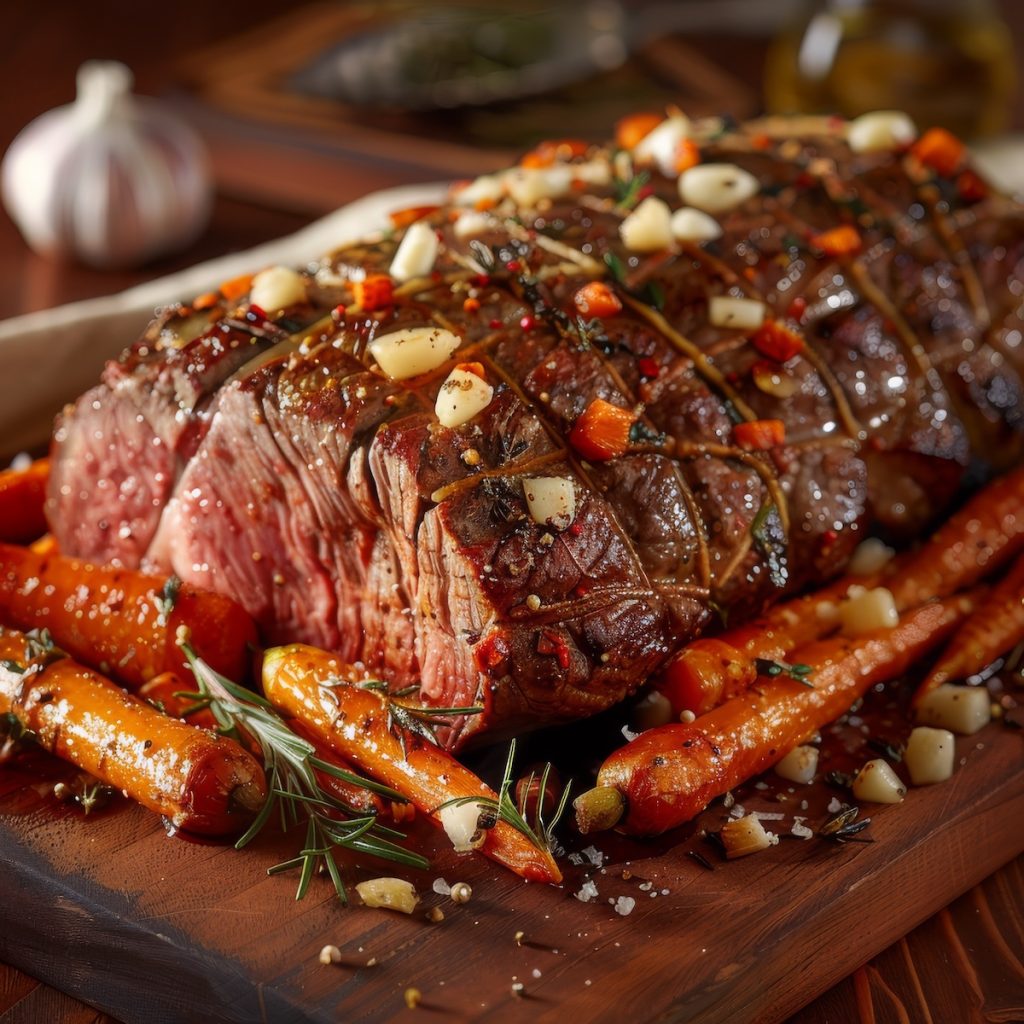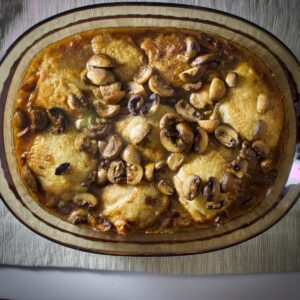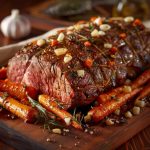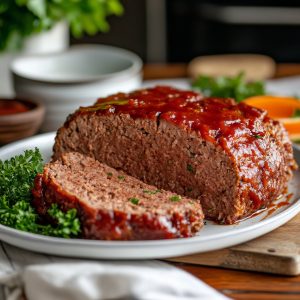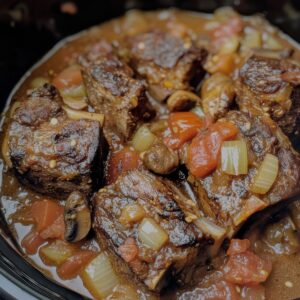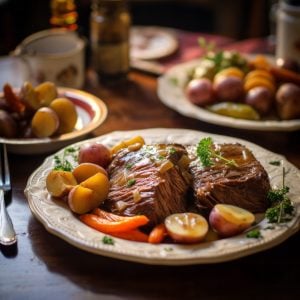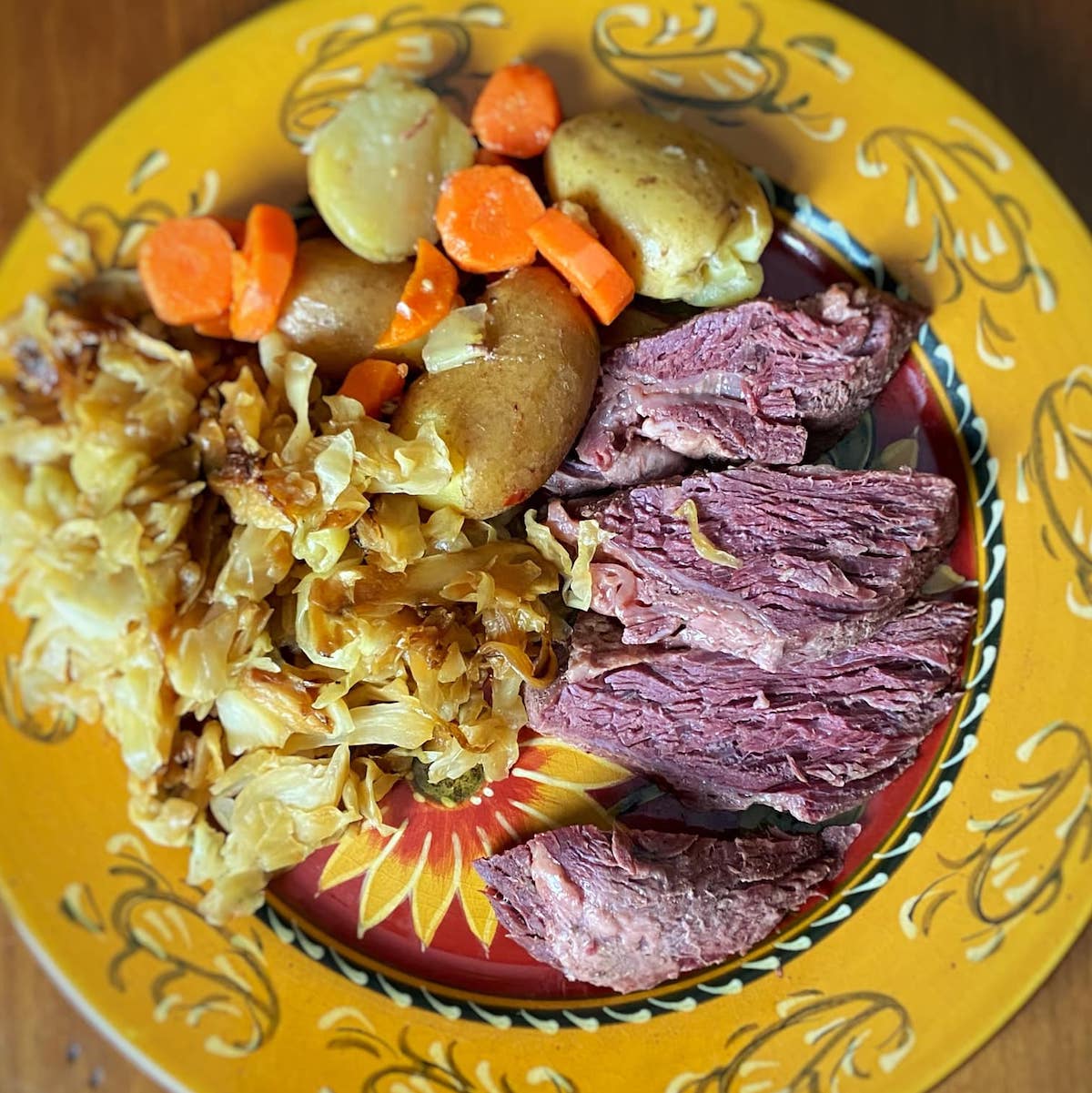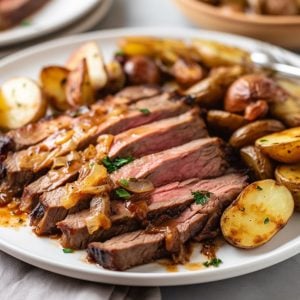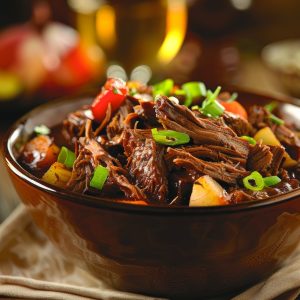A Recipe for a New York Strip Roast
A New York Strip Steak Roast is a luxurious and flavorful dish that elevates the classic strip steak to a centerpiece meal. This roast is crafted from a whole strip loin, a tender, well-marbled cut from the short loin of the cow, renowned for its rich beefy flavor and tenderness. Preparing a New York Strip Steak Roast involves several key steps to achieve culinary perfection.
To begin with, the whole strip loin is generously seasoned with salt, pepper, and a blend of herbs and spices, such as garlic, rosemary, and thyme, to enhance its natural flavors. The seasoned meat is then seared in a hot, oven-safe skillet to develop a beautifully caramelized crust, locking in the juices.
Once seared, the roast is transferred to a preheated oven, typically set around 325°F (163°C), and cooked to the desired level of doneness. A meat thermometer ensures precision, with medium-rare achieved at an internal temperature of 135°F (57°C). After roasting, it is crucial to let the meat rest for about 10-15 minutes. This resting period allows the juices to redistribute, resulting in a moist and flavorful roast.
When ready to serve, the roast is sliced against the grain into thick, succulent pieces. Accompanied by sides like roasted vegetables or garlic mashed potatoes, a New York Strip Steak Roast makes for an impressive and satisfying main course, perfect for special occasions or a gourmet family dinner.
Roast New York Strip Steak
Ingredients
- ½ loin end NY strip loin tied with strings 1-inch apart
- 1 medium yellow onion sliced
- 2 carrots scrubbed and cut in half
- kosher salt and freshly ground black pepper
- 1 clove garlic smashed
- 2 cups dry red wine plus 2 tablespoons divided
- 1 tablespoon tomato paste
- 2 cups beef stock low sodium canned or homemade
- 1 sprig fresh thyme or ½ teaspoon dried thyme
- ½ tablespoons corn starch
- 1 tablespoon butter
Instructions
- Remove meat from the refrigerator about an hour before cooking to let it rise to temperature. Pat the meat dry.
- If your butcher did not tie your meat, tie it at 1” intervals down the length of the cut. Use pieces of kitchen string about 12” long and tie each around the meat so the string is snug but not tight.
- Slice the onion; scrub and cut the carrots.
- Stir together the cornstarch and the 2 tablespoons of red wine.
- Preheat the oven to 400° F.
- Arrange the sliced onion and carrot pieces in the bottom of the roasting pan.
- Place the roast fat side down on top of the vegetables and sprinkle with kosher salt and freshly ground pepper. Using a probe thermometer, insert the probe into the middle of the thickest part of the roast.
- Place the roasting pan, uncovered, in the preheated oven and immediately turn the temperature down to 325° F. Roast at 325° F for 45 minutes, then turn the heat down to 200° F.
- Remove meat from the oven when the internal temperature reaches 125° F for rare, 130° F for medium-rare, and 140° F for medium.
- Place the meat on a wooden cutting board or a warmed serving platter and cover loosely with foil. Let rest for about twenty minutes. The temperature will continue to rise as the meat rests.
- While the meat is resting, place the roasting pan over medium-high heat on the stovetop. You might need to turn on two burners. Bring the pan juices to a boil and cook until the liquids are almost all evaporated and the onion and carrot begin to fry in the beef fat. Make sure to stir constantly and scrape all over the bottom of the pan with a metal or wooden spatula.
- Carefully spoon off/pour off as much of the remaining fat as possible. Put the pan back over medium-high heat and add the wine and smashed garlic. Cook, scraping the bottom of the pan to thoroughly deglaze until the wine has been reduced to only a tablespoon or two.
- Add the beef stock along with the tomato paste and thyme. If using fresh thyme, throw the whole sprig in, as you’ll be straining the sauce before serving.
- Bring all this to a rolling boil and stir in the wine/corn starch mixture (slurry). Turn the heat down a bit and boil gently until the sauce has thickened somewhat and the raw starch flavor has been cooked out. Taste the sauce and adjust the seasonings by adding a little kosher salt and/or freshly ground black pepper if necessary.
- Strain the sauce through a fine mesh strainer, pressing down on the solids. Swirl in 1 tablespoon of butter to add a bit of richness and a nice sheen to your sauce.
- Remove the foil from the roast, cut off and remove the strings. Trim off as much of the surface fat as you’d like, and then slice, passing the sauce at the table.
Cooking Tips For a New York Strip Steak Roast
| Tip | Description | Why It Matters |
|---|---|---|
| Bring to Room Temperature | Let the roast sit out for 45–60 minutes before cooking. | Ensures even cooking throughout the roast. |
| Pat Dry Thoroughly | Use paper towels to remove surface moisture. | Helps create a better sear and crust. |
| Season Generously | Use kosher salt, black pepper, and optional herbs or garlic powder. | Deepens flavor and enhances the meat’s natural taste. |
| Use a Meat Thermometer | Monitor internal temperature as it roasts. | Prevents overcooking and ensures desired doneness. |
| Sear First or Last | Sear in a hot pan before roasting or after for a reverse-sear. | Adds flavor and texture with a caramelized crust. |
| Roast Low and Slow | Cook at 225–275°F for more even doneness. | Results in a tender and juicy roast from edge to center. |
| Rest Before Slicing | Let the roast rest for 15–20 minutes under foil. | Allows juices to redistribute for moist, flavorful meat. |
| Slice Against the Grain | Cut perpendicular to the muscle fibers. | Makes each bite more tender and easier to chew. |
Why Tie A Roast Before Cooking?
Tying a roast before cooking, also known as trussing, serves several important purposes:
- Consistency: Tying the roast helps maintain a uniform shape, ensuring it cooks evenly. This is particularly important for cuts that may be irregular in shape or have thinner ends, as an even thickness helps prevent overcooking the thinner parts while waiting for the thicker parts to reach the desired doneness.
- Aesthetics: When served, a neatly tied roast looks more attractive and professional. The uniform shape allows for more visually appealing slices.
- Flavor Enhancement: Tying the roast can help keep any seasonings or stuffing in place, ensuring the flavors are distributed throughout the meat. Additionally, it helps the roast hold together, which can prevent juices from escaping, keeping the meat moist and flavorful.
- Holding Stuffing: For stuffed roasts, tying is crucial to keep the stuffing inside during cooking. This ensures that the filling cooks evenly and stays in place.
- Stability: Some roasts, especially boneless ones, might flop or fall apart without tying. The kitchen twine provides stability, holding the roast together during cooking and making it easier to handle.
Tying a roast before cooking promotes even cooking, enhances appearance, retains moisture and flavor, and provides structural integrity. These benefits make it a key step in preparing a roast to achieve the best possible results.
Side Dishes That Pair Well With This Roast
| Side Dish | Description | Why It Pairs Well |
|---|---|---|
| Mashed Potatoes | Creamy mashed potatoes with roasted garlic and butter. | The smooth texture and rich flavor balance the roast's boldness. |
| Roasted Brussels Sprouts | Crispy, caramelized sprouts with olive oil and salt. | Adds earthy, slightly bitter contrast to the savory meat. |
| Yorkshire Pudding | Light, airy pastry made from batter and beef drippings. | Classic pairing that soaks up juices from the roast. |
| Horseradish Cream Sauce | Cool, tangy sauce made with sour cream and horseradish. | Cuts through the richness of the meat with a spicy bite. |
| Grilled Asparagus | Lightly charred spears finished with lemon or parmesan. | Fresh flavor and crisp texture complement the roast. |
| Red Wine Mushroom Sauce | Sautéed mushrooms in a red wine reduction. | Deepens umami flavor and mirrors wine pairings. |
| Caprese Salad | Crisp romaine, parmesan, and croutons with creamy dressing. | Offers a cool, tangy contrast to the hot roast. |
| Buttered Green Beans | Tender-crisp beans tossed in butter and herbs. | Simple, fresh, and doesn’t overpower the roast. |

